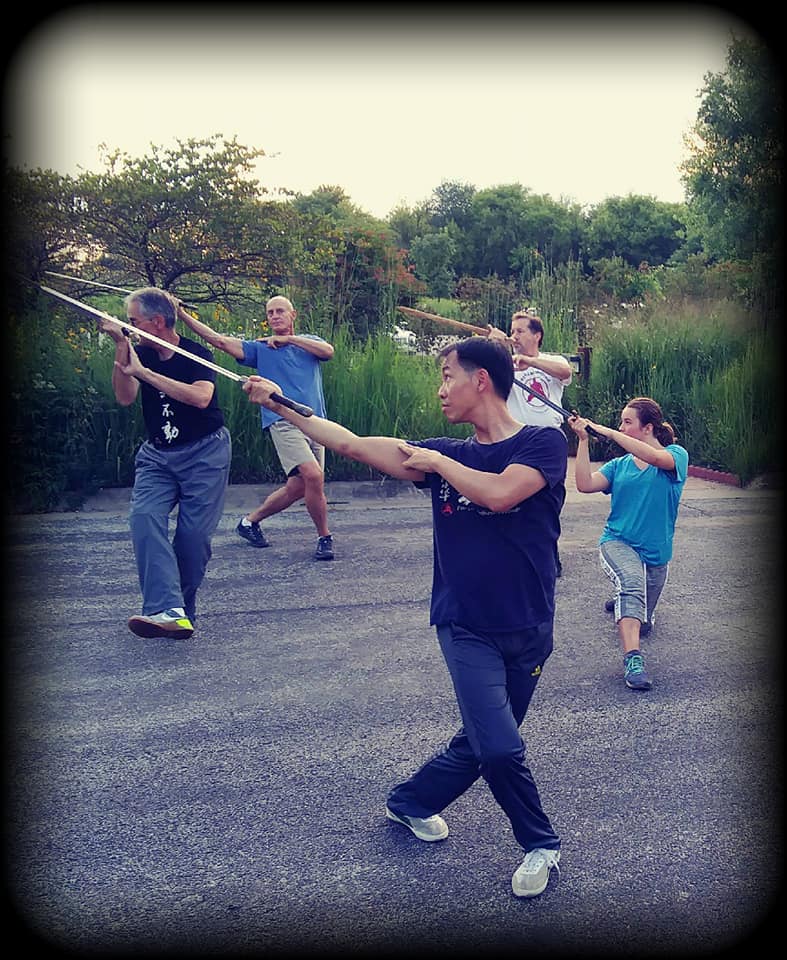 Many thanks go to John Upshaw and Levi Sowers for organzing another successful camp. This is my 4th time attending an Iowa workshop/camp. If you are located in North America, don’t miss out on this annual opportunity to learn from Master Chen Zhonghua in this wonderful environment, which strikes a balance among training, social time, and rest. This is 2nd year in this location for the camp. I saw a lot of returning faces, and it was so great to meet these people again, and saw how everyone had improved since last year. It was a pleasure to share our passion for taiji. The porch talk was probably a highlight among the attendees, at which time, we got a chance to share what you learned in the workshop, what difficulties you encountered during regular training/teaching, and other bits and pieces. This workshop touched on foundations, form and applications. The most significant aspect was that I got a glimse on how the taiji might really be like. It will definitely be very difficult to achieve, however, Practical Method is truly the way to get there.
Many thanks go to John Upshaw and Levi Sowers for organzing another successful camp. This is my 4th time attending an Iowa workshop/camp. If you are located in North America, don’t miss out on this annual opportunity to learn from Master Chen Zhonghua in this wonderful environment, which strikes a balance among training, social time, and rest. This is 2nd year in this location for the camp. I saw a lot of returning faces, and it was so great to meet these people again, and saw how everyone had improved since last year. It was a pleasure to share our passion for taiji. The porch talk was probably a highlight among the attendees, at which time, we got a chance to share what you learned in the workshop, what difficulties you encountered during regular training/teaching, and other bits and pieces. This workshop touched on foundations, form and applications. The most significant aspect was that I got a glimse on how the taiji might really be like. It will definitely be very difficult to achieve, however, Practical Method is truly the way to get there.
Principles and Concepts
Be small
- Getting in
- Touch both hands on the door
- Get in without pushing the door
- Front foot moves first, and rear foot follows
- Establish a connection from front hands to rear foot, so that even if somone behind the door pushs the door, the door is jammed, and you won’t get bounced
- If you over extends yourself, the door can bounce you back if it is pushed against you
- Keep the dantian together
- Don’t extend the torso
- Be integral
- He Zhu (合住)
- Be smaller than the opponent
Be Big
- Be longer than the opponent
- Be bigger than the opponent
To rotate
- Inside needs to be small, the outside needs to be big
Lever
- If the pivot is far from the rear foot (close to the opponent)
- Pro: Small amount of power on the rear side can move the opponent
- Con: Since the pivot is close to the oponent, it is easier for the opponent to disrupt it
- If the pivot is close to the rear foot (far from the opponent)
- Pro: It is like you have a long pole and your power starts far from the opponent, and the opponent can’t easily disrupt it
- Con: It is harder to maintain the integrity of the lever system. As power is applied, the opponent side of the stick can easily fall apart
Past/Present/Future (Delusional/Real/Illusional)
- We must live in the present.
- Many people live in the past, and that’s why they become old because they are left behind by time.
- Future is something you don’t know until you get there.
Always complete the move
What is fighting?
Fighting is to re-establish a new energy path.
Use your opponent’s power to establish a road to guide my energy through. There is no fighting directly.
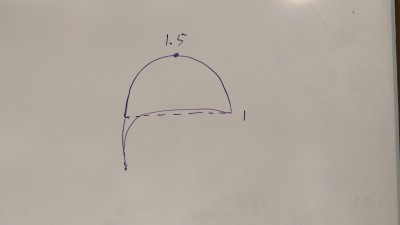
Foot is nine times more efficient than the hand. Always move the feet, and don’t move the hand.
Front of contact point goes forward.
Back of contact point goes backward.
Making it thin, so the dot comes out, e.g.
- Change the dough into a noodle by pulling it open
Getting in
No movement on the front hand, stretch the front heel forward.
No retreat (overall/globally)
- If you look at one part of the body, it may go backward, but there is always another corresponding part that goes forward, so there is no retreat overall.
Don’t leave anything behind
You grow old because you are left behind by time, as it constantly goes forward, e.g.
- People not adapting to change are living in their old way of life
Song
Song means to let something be the way it needs to be.
How to lock
Use other points to lock the point you really want.
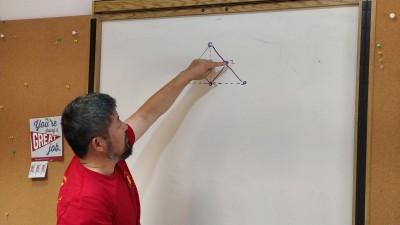
Fire and Water
Fire – Heart
Water – Kidney
CV 17/Tan Zhong/Middle of chest needs to sink to dantian
Push the Mingmen out
The above allows the reversal of the position of fire and water, so that the fire can boil the water to create circulation.
When fire and water are in the right position, a lot of saliva immediately is produced. Elixir in the mouth (after heaven).
It needs to be swallowed in a special way nine times.
Master Chen mentioned something about golden elixir, which was grand medicine.
We must be taught
Every basic thing is given to you. You don’t invent it yourself.
Every good athlete is beaten up or so to speak by the coach. This is really the traditional way to get something in you.
Transmission
Master Chen puts a seed in you by showing how to do something correctly.
It is common that it can be replicated by ourselves immediately right after. However, it is recorded in our brains. This is what transmission is about. It is a matter of time and diligent practice when we can replicate it at will.
Progression of yilu
- Learn the choreography
- Make it smoother
- Learn the relationship of body parts
- Learn to position the body parts
Position is everything. You need to put yourself in very specific position.
If there is no resistance, there is no power.
Imagine that this is an opponent that gives you restriction, and your resultant action has to go over it.
Follow one system completely
- When doing taiji. just do taiji.
- When doing qigong, just do qigong.
- Don’t bring the two together.
- You may or may not find them the same in the future.
- At the learning stage, do not mix them together.
Tense and loose go together
- The chest tenses up and then the hand can be loose.
- Our problem is no separation. When we tense up, everything tenses up. When we are loose, everything is loose.
Thick and Thin
If the opponent is thick, stretch him.
If the opponent is thin, cut him.
Do everything to make the opponent lose the integrity, the opponent must fall apart before we strike.
Power has nothing to do with the opponent, e.g.
- We pull a bow to shoot an arrow. The power is generated when we pull the bow.
You need three nails to balance the power.
Exercise: Finger tip, Back of Head, Heel
Dimensions
Related things are in the same dimension.
Unrelated stuff is being mixed up by people.
3 points in life
- We have habits
- We are justifying why our habits are right
- We are lazy (Avoid the truth, avoid the issue) 不面对
How to split open
- Dot in space, we stuff it so much that it splits.
- Force two things that are 1.1 units in length through an opening is only 2 units in length
- Master Chen when young did an exercise to pull something open. He was not strong as his brothers to pull it open. He squeezing his arms and chest through by holding the two ends fixed.
Peng
Never lose the peng.
Major feature of Practical Method
- Twist (mistakenly pronounced as elbow in the 8 methods)
Promotion
There are only 3 ways to promote:
- Focus on the proper lineage
- Win lots of awards
- Be very famous
Be the number one in what you do.
Lineage is only passed on to one guy.
An emperor will kill others because others will bother him. The new emperor is not picked by the previous emperor because of luck, it is because the new emperor possesses what it takes. There is only one person who has it.
Form Correction
Lean with back (Bei Zhe Kao)
Push the left kua out to stretch that line from right hand to left foot.
There must be a fixed point in every move, so that every action is a stretch relative to that point.
My actions need to be much bigger. Train the actions to be big.
Fall into split
Lock rear foot and front kua to form a line, make the rear kua go to the other side of that line.
Drills
Kua must find the elbow
- Put my left thigh behind the opponent’s right thigh.
- Lock the arm and knee.
- Stretch the left kua under the opponent’s right thigh to go to the other side.
- Stretch the right arm in the opposite way to create the scissors effect.
- Make sure that the right elbow finds the left kua
Worked with Winston Wang on the following:
- Lock the front arm and the front shoulder.
- Stretch the part that is just behind the shoulder under the locked shoulder
- Stretch the front kua forward
- Lock the front knee
- Do an elbow-in and then hand-out with the rear arm to send the opponent out
- This is related to how to get in when the opponent pushes on me.
Worked with Todd Elihu on the following:
- The opponent pushes on my dantian.
- Fill the front kua and lock it
- Sink the chest down
- Put my hands under the opponent’s forearm
- Locate the opponent’s centre
- Lock my front
- Use my rear kua to hit the opponent’s centre
Worked with Edward Liaw on the following
- Six Sealing Four Closing
- The opponent provides resistance holding on my two wrists and pushing them towards each other.
- Chin down.
- Pull the back of the head up.
- Create a line between right hand and left elbow (Aligning the left elbow with the right middle finger tip is different as we cannot see our own back)
- Only the right hand can go forward.
- Push the right foot to cause the front of my dantian to go from right to left while pushing the left foot to cause the back of my dantian to go from left to right.
- There are two lines produced (one in front of the dantian and one behind the dantian).
- The push from the two feet causes the torso cylinder to turn, and it also causes the line formed between the right hand and left elbow to be longer.
- Front and rear sides go in the same size.
- There is absolutely no push towards the opponent. No power up on the arms. The movement of the arms are caused by the push from the feet.
- The sensation here is very weird. I am only focusing on my own actions (pushing the two feet), and the opponent is simply repelled as a result.
- Master Chen said, “It is so tight that it turns”.
- John Upshaw said, “If it is not tight, it is not right. “
- I can only imagine how difficult this is to do this in the entire form.
Fetch water drill
- Make sure that the tip of the middle of finger touch the same dot at the end of handout.
- Hong taught Master Chen to poke the sword at the same dot on the tree.
Twisting the towel drill
- Point the right middle finger at the opponent’s centre line
- Lock the aim
- The opponent provides resistance by holding my right wrist
- Common problem: we push the arm forward.
- Objective: Make a dot comes out of the right middle finger. Only that dot goes forward, everything goes backward.
- Move the head backward will cause that dot to go forward.
- Imaging that the arm is going through a pipe, and the arm itself can’t hit the side of the pipe.
Redirecting opponent’s force
Two ways:
- Redirect the opponent’s force to my rear foot
- Redirect the opponent’s force back to the opponent’s rear foot, nothing is on my body
Matching the opponent
If the opponent pushes me on my chest, match that force back at the opponent’s centre or at his shoulder. The result is that opponent may be bounced.
Negative Circle (3rd count) drill
- Put my right thigh behind opponent’s left thigh
- Put my right arm across the opponent’s chest
- Stretch open the opponent’s torso
- Stretch my right hand out and around the opponent’s fixed point (don’t push the opponent’s chest)

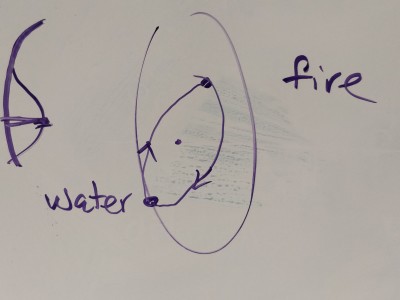
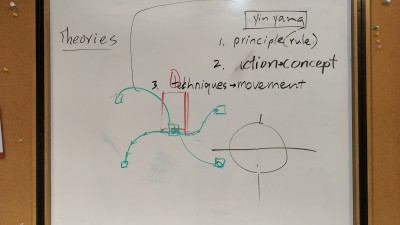


{ 5 comments… read them below or add one }
Great notes! Many thanks Kelvin.
Thank you for the notes. Very detailed.
wow, a lot to digest, awesome notes Kelvin
This is very detail notes and summary of Kelvin own observation, with important parts clearly stated (albeit without diagram/video).
I can imagine myself being there doing the same drills with you folks, excellent notes!!! Thank you Kelvin.
Questions: Would you elaborate “action needs to be much bigger”? Did you refer to stretching, inside or outside bigger? and how would you suggest training yilu with this in mind?
Thanks again!!!
Exaggerate the actions when training the form. Go low, go to the biggest when you are supposed to do hand-out, go to the smallest when you are supposed to do elbow-in, go to the maximum.